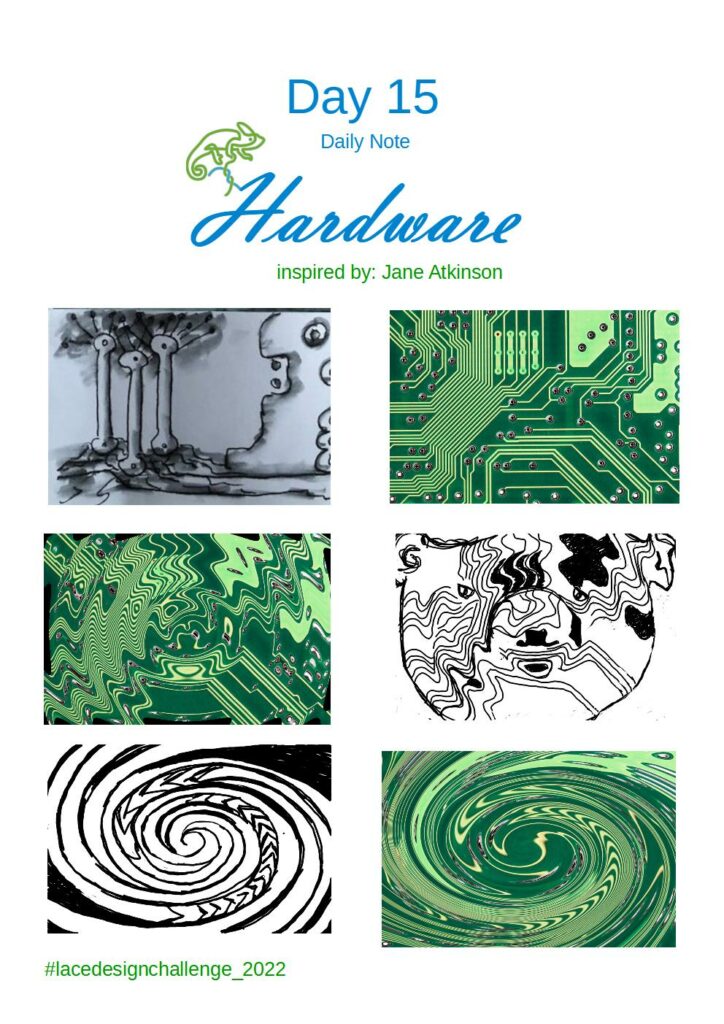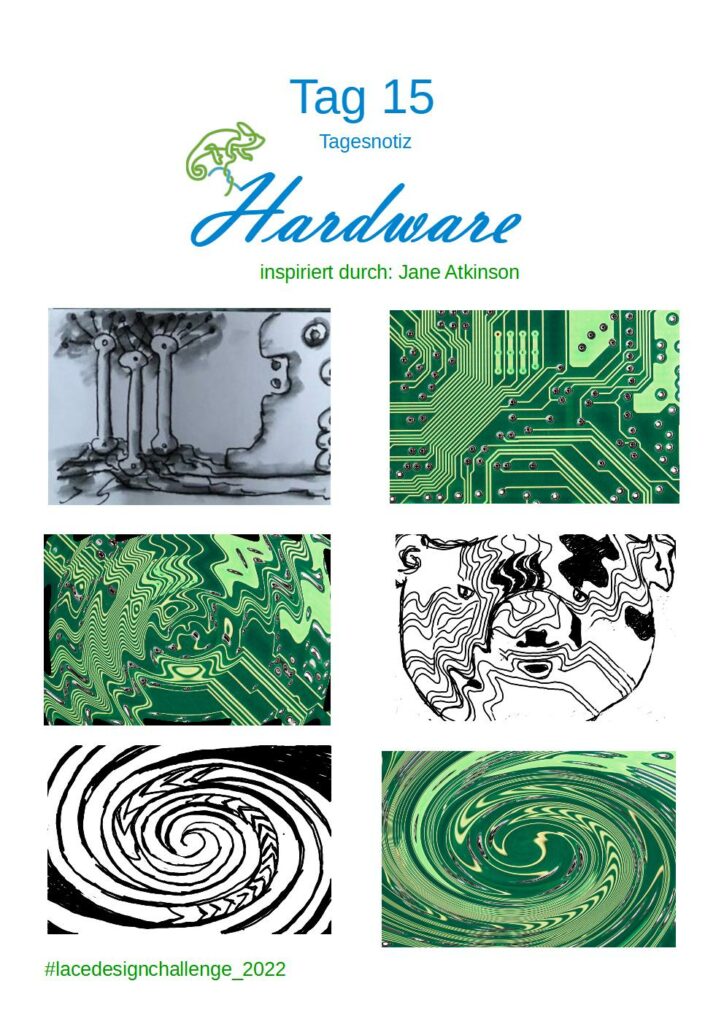For the German version please scoll down.
This post is part of the Lace Design Challenge 2022.

What does hardware, of all things, have to do with lace? Well, directly probably nothing, but there are similar problems. For example, if you want to put a lot of conducting paths on a board, the question is how to do it in sucht a way that the traces don’t cross each other at all, if possible. with as few crossovers as possible. This reminds me of the problem in Milanese Lace, when you want to fill an area with one single trace with as few crossings as possible.
Perhaps hardware has more in common with lace than it seems at first glance.
Instruction
- Go to pixabay.com. Pixabay is a community of creatives, sharing copyright free images, videos and music.
- Enter the word „hardware“ into the search field and look at the pictures. Which image does your gaze linger on?
- Take this picture and use it as inspiration for your design. You have several options here, such as:
- You can print it out, put a tracing paper over it and trace what you like and experiment with it further.
- You can just put it in front of you and then draw the part that interests you, for example using the technique blindly.
- You can load it into an image processing program and modify it using the available filters, for example, and draw the parts that interest you.
- If you like, publish the picture that inspired you and your design using #lacedesignchallenge_2022. Don’t forget to mention the artist whose photo inspired you. He will be pleased.
Tip
If you just can’t think of anything, then try the following:
- Print out the image that makes you pause for a moment. Preferably several times.
- Take a felt-tip pen or something similar and fill in areas on the picture as you like or run a pen over the edges in the picture.
- Take your time and see what emerges. Always remember, if you don’t like it, it’s just not ready yet.
- Trust your design process.
Klöppelentwurfstechnik 15 – Hardware
Dieser Blogpost ist Teil der Lace Design Challenge 2022.

Was hat ausgerechnet Hardware mit der Spitze zu tun? Nun, direkt wahrscheinlich nichts, aber es gibt ähnliche Probleme. Wenn man zum Beispiel viele Leiterbahnen auf einem Board unterbringen will, stellt sich die Frage, wie man das so macht, dass sich die Leiterbahnen möglichst gar nicht kreuzen. Das erinnert mich an das Problem in der Mailänder Spitze, wenn man eine Fläche mit einem einzigen Band füllen will mit möglichst wenigen Überkreuzungen.
Vielleicht hat Hardware doch mehr Gemeinsamkeiten mit Spitze, als es auf den ersten Blick scheint.
Anleitung
- Gehe zu pixabay.com.Pixabay ist eine Gemeinschaft von Kreativen, die urheberrechtsfreie Bilder, Videos und Musik austauschen.
- Gib das Wort “Hardware” in das Suchfeld ein und schaue dir di Bilder an. Bei welchem Bild verweilt dein Blick?
- Nimm dieses Bild und verwende es als Inspiration für dein Design. dabie hast du verschiedene Möglichkeiten, wie z.B.
- Du kannst es ausdrucken, ein Transparentpapier darüber legen und das durchpausen, was dir gefällt, und damit weiter experimentieren.
- Du kannst es einfach vor dich legen und dann den Teil, der dich interessiert, zeichnen z.B. mit der blindlings-Technik.
- Du kannst es in ein Bildverarbeitungsprogramm laden und z.B. über die verfügbaren Filter verändern, und die Teile, die dich interessieren nachzeichnen.
- Wenn du magst veröffentliche das Bild, dass dich inspiriert hat, und dein Ergebnis unter #lacedesignchallenge_2022. Vergiss dabei nicht die Künstlerin zu erwähnen, die dich inspiriert hat. Sie freut sich bestimmt darüber.
Tipp
- Drucke das Bild, das dich für einen Moment innehalten lässt aus. Am besten gleich mehrmals.
- Nimm einen Filzstift oder etwas ähnliches und fülle nach Lust und Laune Flächen auf dem Bild aus oder fahre mit einem Stift über die Kanten in dem Bild.
- Lass dir Zeit und schaue, was entsteht. Denk immer daran, wenn es dir nicht gefällt, ist es einfach noch nicht fertig.
- Vertraue deinem Entwurfsprozess.
